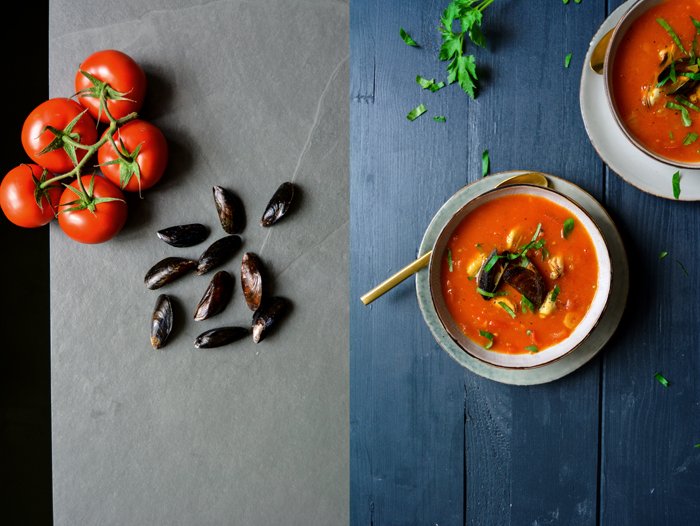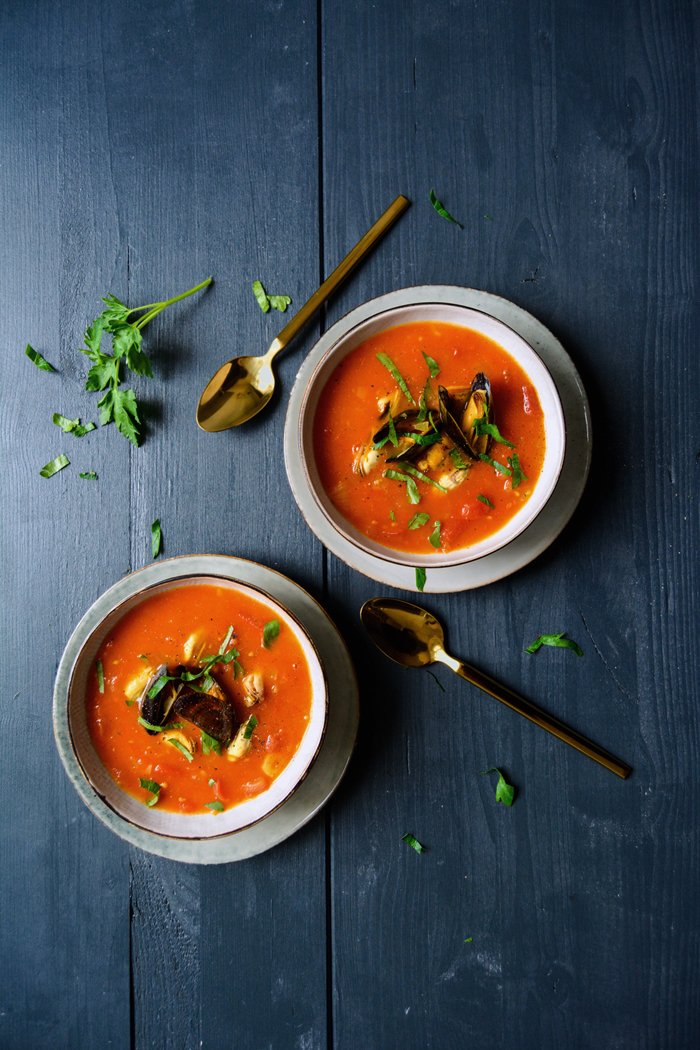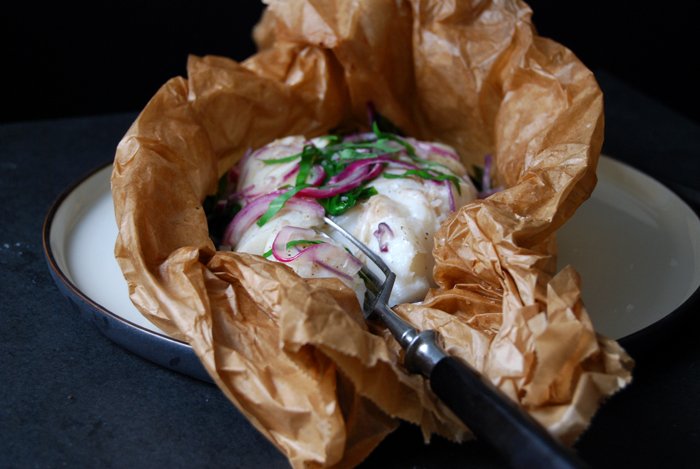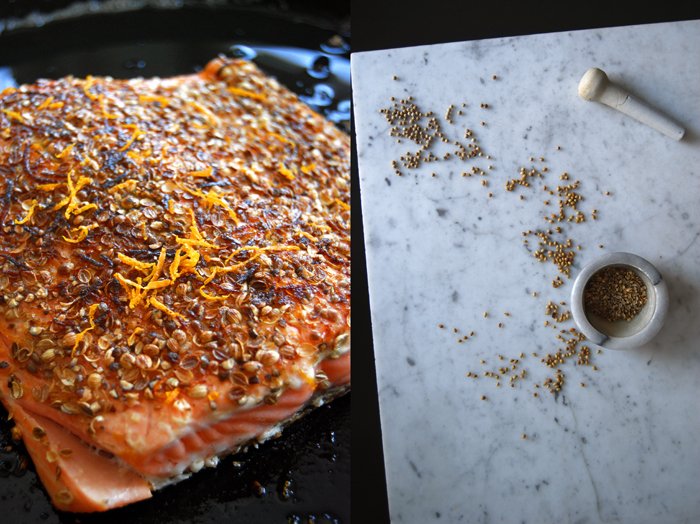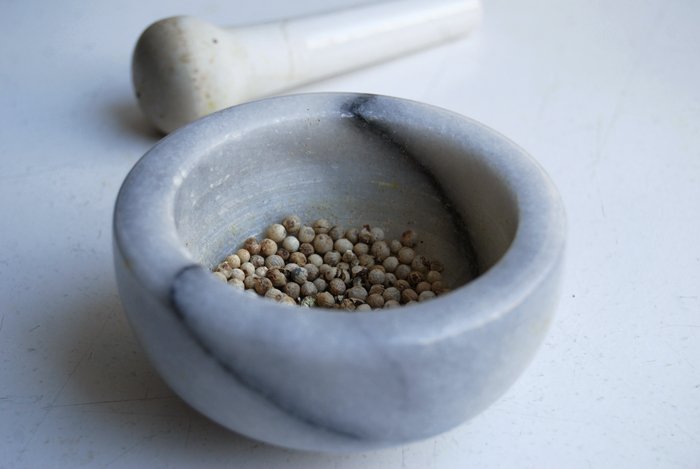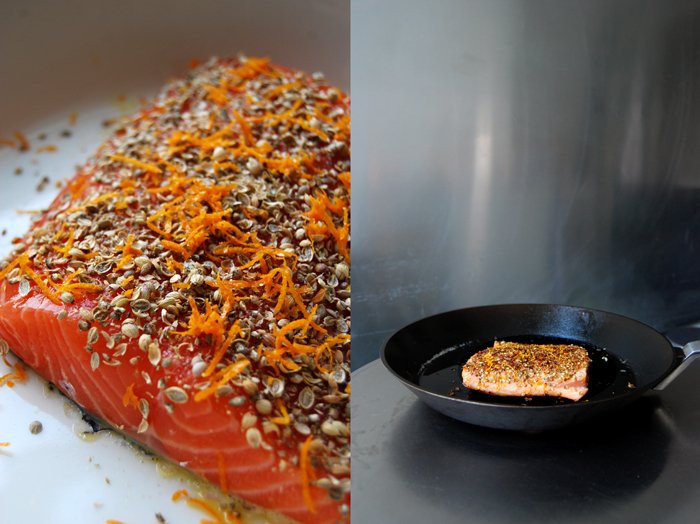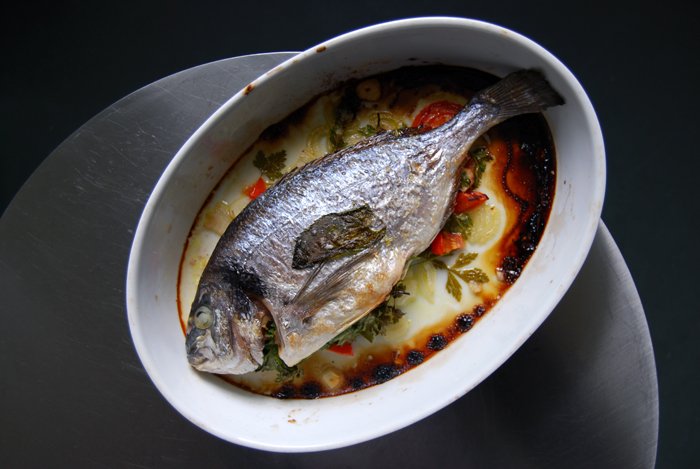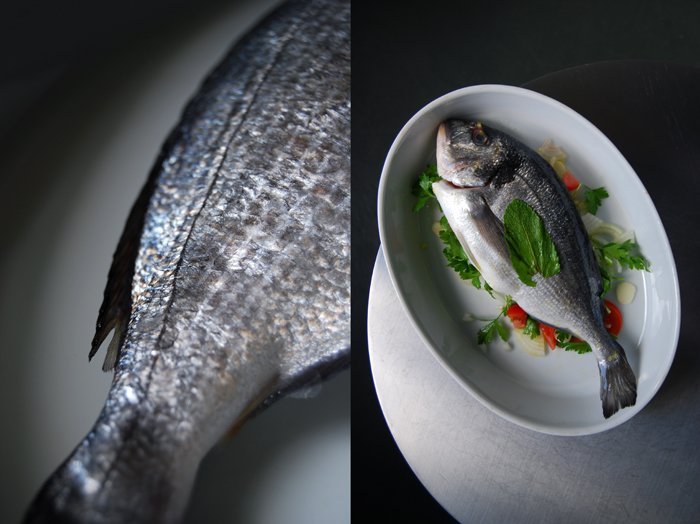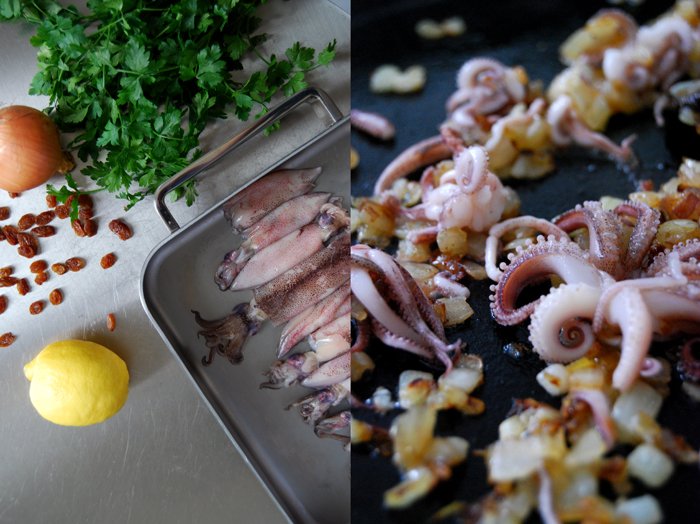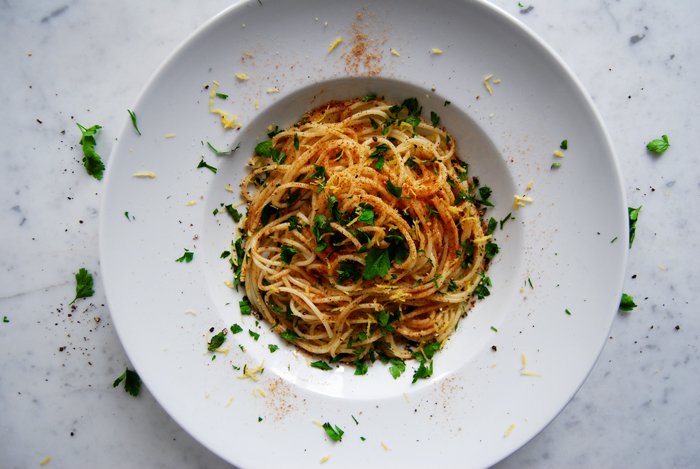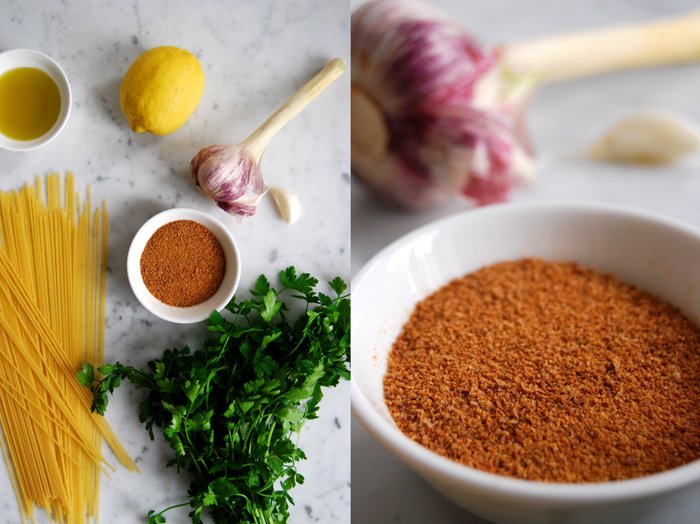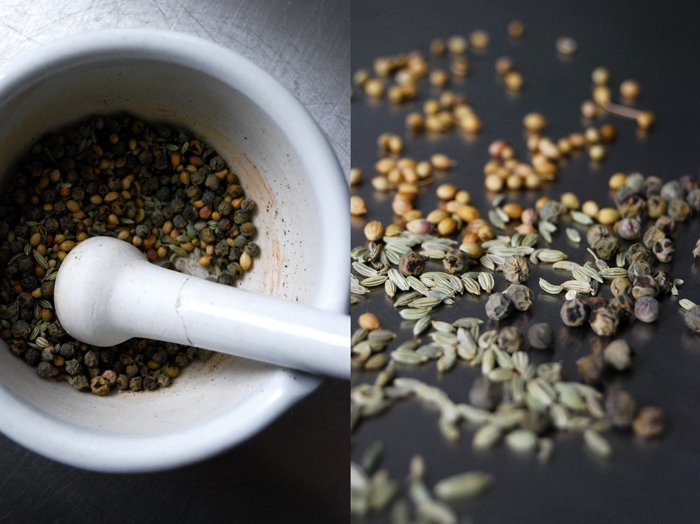Langostini al Cartoccio cooked in seawater
Malta, August 2017:
I'm sure I spent more time in the water than on land in the past few weeks. When I'm in Malta, I turn into a fish, I practically live in and from the sea. Crystal blue water, secluded bays, and hidden caves under limestone arches are my very own little Mediterranean paradise. And once I'm out of the water, there's often the freshest seafood on my plate. Simplicity rules Malta's summer cuisine, a whole fish or pink crustaceans from the grill seasoned with a squeeze of lemon and some parsley from the fields, tender octopus in an aromatic stew - great quality ingredients don't need much to shine.
Although I enjoy visiting the islands' villages on Malta and Gozo a lot, walking down the quiet alleys and stopping for a cappuccino or ice cream at one of the old cafés, if there's a chance to put my goggles on and snorkel, you can be sure to find me in the water within a split second. In the first week, I went to my beloved Fomm ir-Riħ to sadly find the gravel beach considerably narrowed by clay swept down from the steep hill behind it. The sea was rough, so I didn't even bother walking down the hidden track along the cliff face. I went to Sliema's city beach instead and finished the day with my obligatory sun-downer - a glass of Ricard at the Exiles bar. Sitting on the warm rocks and smelling the salty air - after a dip in the sea of course - is one of the best ways to end a day in the Mediterranean.
Another trip took me to Marsaskala, a seaside village that I never really gave the attention it deserves. It's a very Maltese place, not many tourists, old houses, bars, and palm trees lined up along the promenade where the young and old meet after sunset. I had a Ftira sandwich for dinner, but before I dove into village life I discovered a beautiful rocky beach north of the Xrobb l-Għaġin Temple. It was so peaceful, the endless sea framed by chalk-white cliffs softly sliding into the water.
On one of my trips to Gozo, I discovered a recipe that I'd love to share with you today. Noel, the excellent chef at his open-air restaurant at the deep Mgarr ix-Xini bay - which is a bit tough to find - cooked the sweetest langostini al cartoccio in seawater. He doesn't have to go far, a few steps from his place he finds the cleanest Gozitan sea, always at hand to cook seafood in his preferred method: wrapped in a package, al cartoccio, with a splash of seawater, on the grill. Don't worry if you don't happen to live at the sea, just use normal water mixed with the best sea salt you can find, that's what I do at home. I got Maltese langostini, which are the sweetest I know. Noel's crustaceans were a little smaller than mine and tastier, however, my fish monger only had the larger size. You just have to add some lemon wedges to the package and cook it on the grill for a few minutes (or in the oven). They cooked to perfection, with a gentle touch of the salted water. I used Gozitan salt, which I find not only subtle in saltiness, but also tastier than any other I've tried. Choose a good one, it's worth it!
Seawater cooked Langostini al Cartoccio from the Grill
You can cook the langostini on the grill or in the oven.
Serves 2
extra wide aluminium foil
medium langostini, fresh and uncooked, 8-10
sea salt 1 tablespoon
water, warm, 300ml / 1 1/4 cups
olive oil
organic lemon, cut into wedges, 1
Start the grill or preheat the oven to 200°C / 400°F (conventional setting).
Lay 2 pieces of aluminium foil on top of each other, large enough to wrap the langostini.
Stir the salt into the warm water and let it sit until the salt dissolves. Or, if you happen to live close to the clean sea, use the same amount of fresh seawater.
Lay the langostini in the middle of the aluminium foil and fold up the sides. Add the salted water / seawater, a generous splash of olive oil, and the lemon wedges. Wrap the package and seal the ends well.
Cook the langostini for about 3-5 minutes on the grill (I closed the lid of the grill), or in the oven, until they are just done.
Serve immediately with fresh bread and, if you like, a glass of chilled white wine.
Maltese Stuffed Bell Peppers from my cookbook & a short trip to Malta
Old cities and beaches, seafood and wine! When Condé Nast Traveler asked me to take over their Instagram Stories last weekend and share some of my favourite spots in Malta, I immediately booked the flights. There's no way I would miss a chance to visit my second home!
I'm in the Mediterranean for just a few days at the moment, but it's enough time to visit my personal hot spots. An early morning boat ride starting in Sliema took me to Valletta to enjoy my first espresso of the day at the beautifully old fashioned Prego Caffe on the capital's narrow South Street. It's a beloved morning ritual of many locals, nibbling on buttery breakfast pastizzi filled with ricotta surrounded by the café's original 60's decor. A quick visit to the Baroque Saint Francis of Assisi Church (1607) and then I strolled through the streets - one of the most relaxing things I can imagine. If it had been a Sunday, I would have gone to St. John's Co-Cathedral's early morning mass, which is held in Latin accompanied by the most heavenly sounding choir.
On the way to my next destination, Casa Rocca Piccola, I stopped by at the peaceful Lower Barakka Gardens. This place always manages to overwhelm me with its stunning views over The Grand Harbour and The Three Cities - and its almost meditative atmosphere. Frances de Piro was so kind to show me around the 400 year old private Valletta palace Casa Rocca Piccola, where she lives together with her husband, the 9th Marquis de Piro who's a Knight of Malta, and their family. Many of the private rooms can be visited during guided tours and are a must see for everybody who loves art, history, and architecture.
My man joined me for lunch, which turned into a little feast at Scoglitti right at the sea at the Marsamxett Harbour facing Sliema. Pasta with Maltese prawns, swordfish from the grill, and a bottle of Meridiana Wine Estate's fruity white. Maltese Mqaret filled with dates for dessert and we were ready for a nap. Only the thought of an afternoon swim in Malta's deep blue waters could stop us from having a siesta. We chose the secluded Delimara bay, limestone rocks and crystal-clear turquoise sea are the best conditions for a good snorkeling trip.
My perfect day in Malta wouldn't be complete without having dinner at Legligin, my favourite restaurant in Valletta offering the most delicious Maltese tapas cooked by our friend Chris. And if it's a Friday night, you can stroll over to Bridge Bar for their weekly open air Jazz concerts. Sitting on red cushions on the capital's ancient stairs in front of the bar, sipping on a glass of pastis, and listening to good music make me ask myself why I should ever leave the Mediterranean (sorry Berlin).
As part of the Instagram takeover, I also shared a recipe from my Eat In My Kitchen cookbook on Condé Nast Traveler's website. It's a Maltese classic: stuffed bell peppers. Stuffed vegetables are a staple in every Maltese home. Tomato, zucchini, eggplant, pepper are filled with meat, seafood, or other vegetables and turned into the coziest treat to please a large Mediterranean family's appetite. In my version, which you can find below, I go for green peppers cooked al dente - I don't like them too soft and soggy - stuffed with white fish like cod, tiny zucchini cubes, tomatoes, and parsley refined with a shot of vermouth.
If you can't travel at the moment, just cook a dish that reminds you of your favourite holiday spot, close your eyes, and you'll almost be there.
Maltese Stuffed Bell Peppers with Cod, Tomatoes, and Zucchini
from Eat In My Kitchen, To cook, to bake, to eat, and to treat
Serves 4
4 to 5 medium green bell peppers
Olive oil
1 ½ tablespoons butter
510g / 18 ounces cod fillet (or any firm, white fish, such as monkfish or grouper), preferably 1 thick center piece
Fine sea salt
Ground pepper
1 medium onion, finely chopped
1 large clove garlic, crushed
340g / 12 ounces zucchini, cut into very small cubes
60ml / ¼ cup dry white vermouth, like Noilly Prat, or dry white wine
1 medium tomato, cut into small cubes
3 tablespoons chopped flat-leaf parsley leaves, plus 1 to 2 tablespoons for garnish
Preheat the oven to 220°C / 425°F.
Cut the tops off the peppers. Scrape out and discard the seeds and fibers, then rinse the peppers and set aside.
In a heavy pan, large enough to fit the fish, heat a generous splash of olive oil and the butter over medium-high heat. Sear the fish, turning once, for 1 to 3 minutes per side or until golden and flaky—mind that you don’t overcook it. Remove from the heat, break the fish into chunks, and season to taste with salt and pepper.
In a large, heavy pan, heat a splash of olive oil over medium-high heat. Add the onion and sauté for 2 to 3 minutes or until soft and golden. Add the garlic and sauté for 1 minute. Pour in a little more olive oil, add the zucchini, and season to taste with salt and pepper. Sauté for about 4 minutes or until soft. Add the vermouth and cook, stirring and letting the alcohol burn off, for about 10 seconds. Take the pan off the heat, stir in the tomato and parsley, and season to taste with salt and pepper.
To combine the filling, spread half the zucchini-tomato mixture on a large plate, lay the fish on top, and finish with the remaining vegetables. Adjust the seasoning if necessary.
Season the inside of the bell peppers with salt and pepper. Using a large spoon, generously stuff the peppers with the zucchini-cod mixture without pushing on the filling too much. If you have leftover filling, stuff the fifth bell pepper. Place the tops on the peppers and place them in a baking dish. Add a splash of water to cover the bottom of the dish and bake for about 25 minutes or until the bell peppers are al dente and the tops turn dark. Take the peppers out of the oven, sprinkle with more parsley, and serve warm.
Ramp and Prosciutto wrapped Monkfish with Spring Peas
I didn't have many cookbooks when I was younger, I learned all about cooking from my mother. She's my mama bird in the kitchen, I just watch and follow her. Then, in my late teens, she gave me my first cookbook, a detailed introduction to the most important basic techniques covering everything from eggs to soups, meat, seafood, and vegetables. It felt like she wanted to be sure that I wouldn't starve when I moved out. The book was published in the 80's and beautifully photographed. Quite minimal. I think, in regards to food photography, this book influenced my style of capturing food in pictures more than any other publications.
It was my only cookbook for a long time, but I collected and wrote down recipes myself whenever I got the chance to sneak a kitchen classic from a friend or my family. Even in restaurants, I was never shy to ask, if they'd share a recipe with me (the ones that really hit me). This strategy led to a bursting folder packed with notes, snippets, and sheets torn out of magazines. I still haven't cooked and baked all of the treasures collected in more than 30 years. It's a steadily growing project.
As I got into collecting cookbooks, Jamie Oliver's books were one of the first added to the shelves. First as a present from friends, but later on I bought a few myself. I liked his style of playing with food. I was in my early twenties, I had seen and tasted many German, French, and Italian traditional classics cooked to perfection, by my mother and in friend's kitchens, or at restaurants. But I felt like a younger voice. And Jamie's voice felt just right at that time. In the end, I might have only cooked about 15 of his creations in all those years, but he inspired me a lot. And at least 5 of his recipes became staples that I still embrace today.
There's one recipe that I've been wanting to try for more than 15 years. And again, I didn't use it to follow, but to play with: Jamie wraps monkfish filets in prosciutto spread with pesto. It's so simple, it looks stunning. As spring is in the air, or at least the smell of ramps as you enter the woods, I decided to wrap my firm white fish fillet in ramp leaves and prosciutto di Parma. Thanks to Jamie, the cooking time and temperature were perfect. The fillet was tender yet firm. And the wrapping was spot on: green, fresh, and slightly salty.
If you're still looking for an Easter menu, what about skipping the traditional lamb roast and go for seafood? This dish is so easy, serve it with a bowl of lemony ramp peas and baguette (for the lazy ones like me) or Mediterranean mashed potatoes (either from my book, or try this recipe). And what about an eggnog sponge cake for dessert?
Have a wonderful Easter time with your loved ones!
xx
Ramp and Prosciutto wrapped Monkfish
Serves 2
olive oil
monkfish fillet, a thick center piece, 250-300g / 9-11 ounces
fine sea salt
ground pepper
prosciutto di Parma (or San Daniele or Serrano) 10 very thin slices
fresh ramps leaves, a small bunch
peas, fresh in shells (about 400g / 15 ounces) and peeled, or frozen (170g / 6 ounces)
freshly squeezed lemon juice, 1-2 teaspoons
Preheat the oven to 200°C / 400°F (conventional setting) and brush the bottom of a baking dish with olive oil.
Cut the monkfish in half (lengthwise) and, using your hands, coat it in olive oil and season with salt and pepper.
On a large chopping board, spread out half the prosciutto (overlapping slices). Arrange a layer of ramp leaves on top (laying across the prosciutto), then lay one half of the monkfish on top (see 5th picture). Roll and wrap the fish tightly and transfer to the oiled baking dish. Prepare the second fillet the same way and lay next to the first fish wrap. Brush the prosciutto with olive oil and bake in the oven for about 15 minutes or until the fish is tender.
While the fish is baking, prepare the peas: Cut 12 ramps leaves into thin strips, set aside. Cook the peas in plenty of salted boiling water for 1 minute or until al dente. Drain and briefly rinse with cold water. In a small saucepan, heat a splash of olive over high heat, add half the chopped ramps, and take the pan off the heat. Stir in the peas and lemon juice and season with salt and pepper to taste.
When the fish is done, using a sharp kitchen knife, cut the fillets into thick slices and divide between 2 plates. Serve with the peas sprinkled with the remaining chopped ramps, crunchy baguette, and chilled white wine.
Salt Baked Salmon Fillet with Dill, Black Pepper and Juniper
If you're still looking for a scrumptious but effortless main course for New Year's Eve and if you like salmon fillet, this is your recipe. After festive days of rich, meaty treats I prefer to start the new year with a lighter dish, seafood, lots of vegetables, or Asian inspired recipes, preferably easy dishes refined with colourful aromas, spices and herbs. Salmon baked in salt crust came to mind, but not a whole fish - I want to keep it simple - only the fillets, sandwiched with a handful of dill, crushed juniper berries and black pepper. Sealed under a mixture of coarse sea salt, flour, cornstarch, egg white and water, it bakes in the oven soaking up all these wonderful flavours. After 50 minutes it was done, which I checked by following Martha Stewart's tip: Insert a metal skewer, if it's warm to the touch, the fish is ready to leave its crusty shell. You have to use a sharp bread knife to cut open the salty crust, this is the only part of this recipe that demands a bit of work. You could also break it but I wanted to open it like a lid - only for visual reasons. The result is perfectly flaky, firm with a subtle hint of sea salt, it can be a bit overpowering on the edges of the fillet but you can easily scratch this excess salt off. I used fleshy fillets tied together with a cotton string, it was enough for 3-4 people - depending on the amount of dishes you're planning to serve. Two thick center pieces of roughly the same size are perfect, you could also fill them with other herbs or thin lemon or orange slices but I wanted to use the flavours which I use for my traditional gravad lax recipe: fresh dill, spicy pepper and fragrant juniper.
During the holidays, I cleaned the shelves in my kitchen, which were in a rather chaotic state, and to my surprise, I found far more packages of the Cini's sea salt than I had expected. They didn't last very long, I needed 1 kg / 2 1/4 pounds to cover my salmon. The Cini's salt comes from the Mediterranean Sea, from Gozo, where the family harvests the white crystals straight from the rocks. It tastes fantastic, it's obviously salty but not in a harsh way, it has a distinct flavour, which you can recognize in the cooked fish. I recommend using high-quality salt for this recipe, although you will discard the crust, it effects the final result tremendously.
A very exciting year has almost come to an end. I look forward to 2016 and I hope it will be more peaceful and united than the year before. My kitchen will be as busy as ever and I can't wait to share more recipes with you, here on the blog and in my first eat in my kitchen book, which will be published in September.
I wish you a wonderful start to the New Year, don't get intimidated by too many resolutions, just enjoy your life!
Meike xx
Salt Baked Salmon Fillet with Dill, Black Pepper and Juniper
Serves 3-4 (for more people you can use bigger fillets and leave them in the oven a little longer)
high-quality coarse sea salt 1 kg / 2 1/4 pounds
plain flour 100 g / 3 /4 cup
cornstarch 30 g / 1/4 cup
organic egg whites 2
water, cold, 75 ml / 1/3 cup
salmon fillet, 2 center pieces with skin (about 680 g / 1 1/2 pounds in total)
juniper berries, coarsely crushed in a mortar, 8
black peppercorns, crushed in a mortar, to taste
fresh dill, 1 small bunch plus 1 tablespoon chopped fresh dill, for the topping
Preheat the oven to 200°C / 400°F (conventional setting). Line a baking dish with parchment paper.
For the salt crust, combine the coarse sea salt, flour, cornstarch, egg whites, and water in a large bowl until combined, use your fingers or a spoon.
Spread a little of the salt mixture on the lined baking dish, lay 1 salmon fillet - skin side down - on top of the salt. Rub a little crushed pepper and half the juniper into the pink side of the salmon, then cover with the dill. Rub the second salmon fillet with pepper and the remaining juniper and lay it on top of the dill - skin side up. Tie the fillets together with a cotton string (see picture below), then cover the salmon with the remaining salt mixture until it's completely covered (see 2nd picture), push the salt mixture together gently. Bake in the oven for about 50 minutes or until a metal skewer, poked through the crust into the thickest part of the salmon, is warm to the touch when you pull it out of the salmon.
Let the crust cool for 1-2 minutes, then cut it open with a sharp bread knife. Cut the string open, divide the fish fillets in 3-4 portions, and serve immediately. Sprinkle with freshly chopped dill on the plates (optional).
Saffron & Mussel Tomato Soup
It's getting colder here in Berlin, all of the trees in front of our windows are finally naked, their last colourful leaves swept away in a single stormy night. Before the winds came, the light in our living room was golden and warm, filtered through autumn's pretty yellow linden leaves. Now that they're gone, the light is much harder. All of a sudden, the city seems a bit more harsh, which made me long for a cozy soup.
Seafood has been on my mind for weeks, sweet mussels from the North Sea, adding their fine taste to a thick, fruity tomato soup refined with aromatic saffron. It warms the body and caresses the soul, what else could you want on a cold and misty November day? This dish may seem elaborate but that's not at all the case, it's a quick one. The fruit's red juices only cook for a bit longer than 10 minutes and the mussels sink into a fragrant broth of white wine and spices for just 5 minutes. I use the wine, infused with a soft hint of the sea and the noble taste of saffron, to stir into my glowing soup. It's supposed to serve 3-4, which I still believe is quite realistic, but we loved it so much that we almost emptied the large pot of soup in one go at lunchtime. We were hungry.
Saffron and Mussel Tomato Soup
Serves 3-4
For the mussels
mussels in shells 1 kg / 2 1/4 pounds
olive oil
medium onion, finely chopped, 1
garlic, thinly sliced, 2
large cloves
white wine 200ml / 3/4 cup plus 2 tablespoons
bay leaves 2
saffron threads 1/8 teaspoon / 1g
sea salt 1/2 teaspoon
ground pepper
For the tomato soup
olive oil
tomatoes, finely chopped, 1 kg / 2 1/4 pounds
garlic, thinly sliced, 1 big clove
broth, used to cook the mussels, 400ml / 1 2/3 cups
a pinch of sugar
sea salt
ground pepper
For the topping
fresh parsley, roughly chopped, 4 heaping teaspoons
Rinse and scrub the mussels under cold water and cut off the beard, discard any broken mussels.
For the mussels, heat a splash of olive oil in a large pot and cook the onion and garlic on medium heat for a few minutes or until golden and soft. Add the wine, bay leaves, saffron, salt and pepper, stir and bring to the boil. Turn the heat down to low, gently add the mussels to the pot, shake the pot or stir with a slotted ladle and close with a lid. Cook for 5 minutes or until the shells open, shake the pot once or twice while cooking. Take the mussels out with a slotted ladle, discard any mussels that don’t open. Measure 400ml of the mussel broth, together with the onions and the bay leaves, and set aside. Peel the mussels out of their shells, leave about 6-8 inside the shells for the topping of the soup (optional). Set the mussels aside.
Heat a splash of olive oil in a large pot, add the tomatoes and garlic and cook for 4 minutes on medium-high heat (open), stir once in a while. Add the mussel broth with the onions and bay leaves, sugar, salt and pepper and cook for about 7 minutes (open) or until the tomatoes are soft and the soup is thick. Season to taste and, if necessary, chop the tomatoes with a knife if they are too chunky, or purée the soup in a food processor. Stir in the mussel meat, divide the soup between bowls, sprinkle with fresh parsley and pepper and garnish with the mussels in their shells.
Peruvian Ceviche and my love of the sea
What I love the most about Malta - besides the wonderful people around us - is the sea. I can sit on one of the rocky beaches for hours staring at the sparkling shades of blue, the salty air in my nose and the the next seafood meal on my mind. Although I'm quite obsessed with snorkeling - I feel a great fascination for the beautiful wonders of Malta's amazing underwater life, I can't help but think about food when I'm close to the sea. We went to the fish market in Marsaxlokk as soon as we arrived and I couldn't resist filling the cooling box with the freshest tuna, swordfish, calamari, Cipullazza (scorpion fish) and sea bream.
The fisherman's wife at one of the stands made us try a selection of raw fish as I was on a mission. I've been wanting to make Peruvian ceviche for months and I decided that there's no better place for my culinary experiment than Malta with its daily catches from the sea. Ceviche is a traditional Peruvian dish made with raw fish marinated in lime juice for a few minutes. Although the citrus fruit's acid creates a chemical process similar to cooking I still wanted to use the freshest fish possible. I also felt that it would be appropriate to taste it raw first to approve the taste of my choice of fish. So we were right in the middle of the market, surrounded by lots of people and the most beautiful seafood offered on large tables when my experiment started. I just thought of sushi when I put one thin slice of fish after the other into my mouth. It felt a bit strange, especially after my fish-stand-lady told me that she would never eat raw fish. She had a mischievous smile on her face, but I trusted and survived.
I've never been to Peru so I decided to ask a woman for help who has lived in Lima for years, she's a passionate connoisseur and food writer. I met Sheila through eat in my kitchen, she is one of my blog's earliest readers and joined me on this journey with great support. We've never met in person but we felt a connection immediately through the universal language of food. My Peruvian lady is originally from Chicago but she dug deeply into her new home's kitchen culture. I knew that I was in the right hands when I asked her for a recipe - and I wasn't mistaken. Her directions led to the most delicious ceviche on our table in Malta, it was surprisingly quick and easy. And yes, lime juice kind of cooks the fish, I couldn't believe it when I saw (and tasted) it! Sheila recommended flounder but I went for Accola (Maltese amberjack) which was my favourite at my raw fish tasting session. I also added some lime zest which isn't usually done in Peru but I love the slightly flowery flavour it adds to the fish. It was quite an exciting kitchen experience but most importantly: my new seafood discovery made the most delicious lunch!
We also had a couple visitors to the island in the past few weeks. My mother decided to hop over for a spontaneous long weekend which we celebrated befittingly. We enjoyed a Maltese champagne picnic with the fantastic Cassar de Malte at a promenade in Valletta before we headed over to a new restaurant find - the Italian Scoglitti right at the sea. They treated us to a huge local Pagell (red snapper) in sea salt crust after we had already enjoyed octopus with potatoes, swordfish carpaccio and pulpetti tal-Makku (white bait pulpetti) along with Meridiana's white Isis wine. It was a feast finished with Maltese Mqaret (date sweets) - the delicious recipe will follow soon!
Another one of my most beloved seafood restaurants on the islands is Rew Rew at Mgarr ix-Xini in Gozo. Noel creates very pure dishes, honest simplicity, always cooked to perfection. We went to the little hidden bay a couple times this summer to enjoy local prawns from the BBQ, fried sardines and makku, grouper ravioli and Bazooka (deep sea snapper). Holly, my editor from New York, joined us on one of these visits and she was more than impressed.
I love the sea and all these wonderful frutti di mare, it's a gem we have to protect and treat with respect!
This recipe has been featured by Food52!
Sheila's Peruvian Ceviche
Serves 4-6
firm, white fish (such as flounder, sea bass or amberjack) 280g / 10oz
medium red onion, quartered, thinly sliced, 1/2
red aji límo (Peruvian habaneros), thinly sliced, 1/4 (to taste)
yellow aji límo, thinly sliced, 1/4 (to taste)
organic limes, zest and juice, 3
fine sea salt
Cut the fish into 1cm / 1/2" pieces. Lay the fish in a large sieve, rinse quickly with cold water, drain and dry with kitchen paper.
Pour the lime juice in a deep bowl, add the fish, toss it around and marinate for 2 1/2 minutes. Take the fish out with a slotted ladle and divide between plates. Garnish with onion and aji límo and sprinkle with salt and lime zest (optionally) to taste.
You can serve ceviche with cooked corn, sweet potatoes and lettuce.
Cod al Cartoccio with Ramp and Red Onion
My beloved ramp is back in season, ready to add its garlicky spiciness to fish, meat and vegetables, and to one of my favourites of course: fragrant ramp pesto!
I've been looking for it impatiently over the past few weeks and when I finally spotted the first bunch at my organic supermarket I had to call my boyfriend instantly, he's almost more obsessed with these green spring leaves than I am. We changed our dinner plans from gnocchi with blue cheese sauce to spaghetti with pesto, and that was just the beginning of our re-awakened green passion! Cod al cartoccio on a bed of ramp and red onions was next on my list. It's not only very delicious but also a very convenient match. I wrapped the fish in a parchment paper package with a little white wine, olive oil and lemon juice and cooked it in the oven for 15 minutes, all in all it took less than half an hour including the preparation! If you're still looking for a light and easy family Easter lunch, think al cartoccio. It cooks the fish to perfection while you can create your desired aroma of herbs and vegetables, it tastes divine and looks beautiful on the table.
Cod al Cartoccio with Ramp and Red Onion
For 2 people you need
cod fillet, about 2 1/2cm / 1" thick, 400g / 14 ounces
ramp, stalks cut off, a large bunch (about 50g / 1 3/4 ounces)
small red onion, cut in half and into thin slices, 1
white wine 2 tablespoons
freshly squeezed lemon juice 1 tablespoon
olive oil 2 tablespoons plus more for the parchment paper
sea salt and pepper
Set the oven to 200°C / 390°F (fan-assisted oven).
Cut 2 large pieces of parchment paper, big enough to wrap the fish, lay them on top of each other and brush the top layer with olive oil. Lay the ramp leaves in the middle of the oiled parchment paper (leave 2 leaves out and put aside), place the cod on top and season with salt and pepper. Lay 1 ramp leaf on top of the fillet and arrange the onions around the fish. Whisk the wine, olive oil and lemon juice and pour over the fish. Close the parchment paper like a bonbon and fold the top twice. Place in a baking dish and cook in the oven for 10-15 minutes. Check after 10 minutes, if you can separate the fish (gently) with a fork it's done, if it needs a little longer close the parchment paper and put back into the oven (mind not to overcook it!). Chop the raw ramp leaf and sprinkle over the cooked fish, serve with fresh baguette and a glass of chilled white wine!
Mediterranean Octopus with Fennel and Orange
This is my favourite octopus recipe, tenderly cooked with star-anise, fennel seeds, bay leaf and garlic before it reveals its fine qualities in a refreshingly light salad side by side with crunchy slices of fennel and juicy orange filets. It's one of the purest ways to savour this seafood which is so unique in taste and so scrumptious when prepared well. Cooked octopus combines a smooth butteriness with the soft sweetness of the fresh sea, it doesn't need much more to caress my taste buds. A little fruity acidity and the flowery aroma of anise and it's complete.
It's that time of year again, when my summer holidays come back to mind and tease me, especially the culinary memories from Malta and Gozo, our second home, and I can't wait to revive them in a few months. This octopus salad makes an annual appearance and will definitely be on my plate more than once. It's one of my personal Mediterranean classics, cooked in my Maltese mother's kitchen and savoured in her garden for lunch, with a glass of crisp Maltese white wine and the sun on my back. So much to look forward to, so let the holiday dreaming begin!
Here's more about the man who taught me to cook octopus with star-anise and fennel seeds, Chef Kurt Micallef from Malta.
Mediterranean Octopus, Fennel and Orange Salad
For 2 people you need
For the octopus
octopus, skinned and cleaned, 300g / 10.5 ounces
star-anise 1 piece
a pinch of fennel seeds
bay leave 1
garlic, cut in half, 1 clove
small onion, cut in half
lemon, sliced, 1/2
For the salad
orange, peeled and cut into fillets, 1
medium fennel bulb, cut into very thin slices, 1, the green chopped
olive oil 3 tablespoons
freshly squeezed orange juice 2 tablespoons
white balsamic vinegar 1 teaspoon
salt and pepper
In a large pot, bring water with the star-anise, fennel seeds, bay leave, garlic, onion and lemon to the boil. Slip in the octopus and cook on low heat (simmering) for about 45 minutes or until the octopus is tender. Take the octopus out of the broth, let it cool and cut into pieces.
For the dressing, whisk the olive oil, orange juice and vinegar and season with salt and pepper to taste. Arrange the slices of fennel on plates and lay the octopus and orange on top. Sprinkle lightly with the dressing and fennel green, serve immediately.
Shrimp Sandwich with Cumin Guacamole, Coriander and Chili Peppers
Sometimes I sit in my kitchen, or on my sofa in the living room, I close my eyes and imagine food. Just food. I can see colourful ingredients, vegetables, seafood, spices and herbs, or beautiful dishes carefully prepared on plates. I don't have to do anything, these pictures appear naturally in front of my inner eye. It's a helpful gift and the reason I never fear running out of inspiration, as long as I take my time to sit down with a cup of tea, relax and let go my kitchen ideas will come to me.
Culinary daydreams are fun and I particularly enjoy the ones about new sandwich creations. It makes me feel like a child in a toy shop. I can pull any ingredient out of the imaginary shelf, mix wildly and create whatever comes to mind on the plates, or I can keep it simple and work (or dream) minimal. Fruit and ripe cheese is always a great match, but there's so much more, sweet and salty, creamy and crunchy, sour and spicy, fresh and aged aromas, there are endless possibilities.
It's an exciting process as I never know how it will taste until I finished taking the last picture and enjoy the first bite. Some recipes are hard to imagine but I always follow my gut feeling (literally) and that's quite reliable. Today I felt like cumin guacamole, it's a great fusion of this distinctive spice and the wonderful velvety fruit, they truly bring out the best in each other! I merged this duo with the salty taste of the sea, fresh herbs and some hot spiciness. Shrimp, avocado, coriander and red chili peppers stuffed between a bun, my daydreaming was right, it was delicious!
Shrimp Sandwich with Cumin Guacamole, Coriander and Chili Peppers
For 2 sandwiches you need
buns, cut in half, 2
shrimps, cooked and peeled, 100g / 3.5 ounces
small ripe avocados, peeled, 2
sour cream 3 tablespoons
freshly squeezed lemon juice, to taste
a pinch of cumin
salt and pepper
fresh red chili pepper, thinly sliced, 1
fresh coriander leaves, a small handful
black peppercorns, crushed in a mortar, for the topping
Cut 1 avocado into slices, chop the second one with a fork and mix with 2 tablespoons of the sour cream. Season with lemon juice, cumin, salt and pepper to taste.
Divide the guacamole between the 2 buns and spread it voluptuously on the bottom half. Lay the shrimp and avocado slices on top and sprinkle with the remaining sour cream, the chili pepper, crushed pepper and coriander leaves. Enjoy!
Salmon with a Coriander, White Pepper and Orange Crust
After a week of daily feasting I need a change in my cooking, some fresh aromas to shake my taste buds a little. Together with my Maltese sister Emma and her boyfriend Mariano we savoured like the Romans, the table was practically piled with paté and cheese, roasts, pies and cookies every day. I need a culinary turnaround to bring back some hot spiciness and light fruitiness to my kitchen. I loved the opulence of December and enjoyed each bite but every feast has its end and I'm definitely ready for that!
I went shopping (the best way to get some inspiration) and seafood was first on my list. I wanted to get a big bag of mussels to steam with fresh fennel, ginger and lots of garlic but a large fillet of salmon changed my plans. It just looked too good so the mussels have to wait. Back home, I took out the mortar, the white peppercorns which I have neglected for months, coriander seeds and an orange. There are tons of oranges in my kitchen at the moment, it looks quite Mediterranean and brings in some brightness to contrast Berlin's monotonous winter grey. I like to squeeze a couple fruits for our morning juices, grate their skin for almost everything I put into the oven and enjoy their fillets as a snack from morning until midnight. For my salmon, I just used the grated skin mixed with crushed peppercorns and coriander for an aromatic crust. It was strong but the the fish's pink meat can take it. I find it easiest to brush the salmon with an egg wash before I dip it into the spices, they stick to it and turn into a crunchy topping. I cooked my salmon in a pan but you could also fry it for just a minute and finish it in the oven. For the crust, I used a bit of orange zest to cook with the fish and sprinkled it with half a teaspoon when it was done. Next time I would put the zest on in the end as the little citrus bits can easily turn dark in the pan and most of the flavour came from the fresh zest anyway. The result was spicy and fresh, exactly what I needed on the table!
Salmon with Spice and Orange Crust
For 2 hungry people you need
salmon fillet, with skin, 400g / 14 ounces
organic egg, beaten, 1
coriander seeds, crushed in a mortar, 1 tablespoon
white peppercorns, crushed in a mortar, 1/2 tablespoon
orange zest 1/2 - 1 teaspoon
salt
olive oil
Dip the salmon in the egg wash (just the side without skin). Mix the coriander and pepper, spread the spices on the pink side and push them gently into the egg wash.
Heat a splash of olive oil in a pan and cook the salmon on medium heat skin side first. Add a little more oil if necessary and quickly turn the fillet around. Turn the temperature down to a medium-low and cook for just 2 minutes. Turn it around again and finish on the skin side for another 2 minutes or until it's cooked through. Season with salt and sprinkle the warm crust immediately (in the pan) with orange zest.
If you prefer to cook the salmon in the oven, fry it for a minute on each side before you sprinkle it with orange zest and cook it in the 200°C / 390°F hot oven for about 6-8 minutes depending on the fillet's thickness.
Saffron Bouchot Mussels with Tomatoes, Garlic and Parsley
When I have mussels on my cooker I like to add spices, herbs and chopped vegetables, lots of flavours to enrich the broth they're cooking in. I love to dip a piece of fresh baguette into the concentrated juice of wine cooked with mussels, garlic and parsley as much as I like the tender flesh.
The last time I wrote about a recipe with mussels, it was an aromatic bomb inspired by my friend Essa's kitchen. The list of spices was long with turmeric, coriander, fresh and seeds, cayenne pepper, ginger and lemongrass. Not too long after I shared this recipe, Marilena from the Molise region in Italy got in touch with me as she holds a completely different position when it comes to cooking mussels and seafood in general. Pure without too many distractions, that's how it should be cooked in her opinion. I understand her point, and agree partly. I prefer prawn and lobster dishes that focus mainly on the seafood. When it comes to grilled steak fish, I feel the same. That's also one of the reasons why my fish recipes in Malta were quite minimal. Although mussels have a very fine taste of the sea, almost sweet, I find they work very well in combination with exotic aromas. We all have our cooking preferences, our likes and dislikes which makes the product of each kitchen so unique! When it comes to baking, Marilena and I found common ground again. She asked me to bake her Milk Pan di Campobasso, a traditional dolci of the region where she lives. This cake is packed with saffron and Strega (an old Italian saffron liqueur) infused milk and covered with hazelnut icing. I had never heard of this combination before but since then I'm in love with saffron combined with nuts!
Today's recipe for my mussels also works with the strong aroma of this precious, red spice. I felt like a strong broth with a dominant note of saffron mixed with tomatoes, bay leaf, parsley, onions and garlic. The dish looked and tasted like autumn! Warm flavours and colours, red, yellow and green on the shimmering Moules de Bouchot from the Mont-Saint-Michel bay between Brittany and Normandy. The mussels grow on ropes in the sea and that's the taste they bring to the plate, the fresh sea!
Saffron Bouchot Mussels with Tomatoes, Garlic and Parsley
For a lunch for 3-4 people served with baguette you need
mussels in shells (preferably Bouchot mussels) 1 kg / 2 pounds
medium tomatoes, finely chopped, 3
medium onion, finely chopped, 1
garlic, thinly sliced, 3 cloves
white wine 200ml / 7 ounces
bay leaf 1
saffron a pinch
salt 1/2 teaspoon
pepper
olive oil
fresh parsley, roughly chopped, 4 tablespoons plus a few leaves
Rinse and scrub the mussels under cold water and cut off the beard, discard any broken mussels.
In a large pot, heat a splash of olive oil and cook the onion and garlic on a medium heat for a few minutes until soft and golden. Add the tomatoes, bay leaf, wine, saffron, salt, pepper and the mussels. Shake the pot gently to mix or stir with a slotted ladle. Bring to the boil, close with a lid and cook on lowest heat for 5 minutes or until the shells open (shake the pot once or twice while cooking). Discard any mussels that didn't open! Sprinkle the mussels with parsley and serve immediately, in deep plates with a bit of broth and baguette.
Crisp Whitebait with Parsley
This was one of our first lunches when we arrived in Malta, but I had forgotten about it: golden fried whitebait sprinkled with parsley! For years I didn't touch this dish as I didn't like the idea of frying little fish in one piece until I tried it in a Portuguese restaurant and I loved it. That dinner changed my mind!
The fish has a fine taste, like the sea, so it shouldn't be mixed with too many flavours. I like to cook a big batch of them and serve them on a big plate, with a salad and a glass of white wine on the side. This is perfect as an easy lunch and it brings a Mediterranean feeling to the table! Close your eyes, smell the aroma of the cooked fish and imagine that you're sitting in a restaurant close to the sea!
When I cook whitebait (a big handful), I like to dust them lightly with flour, dip them in a beaten egg and fry them in 1 tablespoon of butter mixed with 2 tablespoons of olive oil. They just need 3-4 minutes in the pan to turn golden brown and crisp. I sprinkle them with a heaped tablespoon of chopped parsley and a tiny bit of freshly squeezed lemon juice, that's it!
Grilled Amberjack with Mint Oil
Here is another one of our Marsaxlokk fish market purchases, firm amberjack steaks! When I wrote about my Moscato Prawn Pasta last week I mentioned the small town's Sunday market that turns the picturesque promenade at the seafront into a busy scene of fishermen offering their fresh catches and farmers piling up their colourful harvest. Green boxes filled with melons, tomatoes, zucchinis and peaches made my mouth water before we even started our shopping!
The small path between the stalls was packed with people looking for the nicest piece of tuna or swordfish, trying to spot the fisherman offering the freshest Maltese prawns, mackerel, barracuda or octopus. We bought far more than we had planned but we couldn't resist when we saw all the wonderful seafood in front of us. After 30 minutes of choosing the fish we wanted and bargaining here and there, we started to feel a bit exhausted. The heat reached its peak and forced us to take a break. We ate a nice big watermelon, sweet and juicy and found a little spot in the shade right next to the colourful boats swaying gently in the crystal clear water.
Sometimes when we visit Marsaxlokk we sit down in one of the cafes at the piazza in front of the church and enjoy a little snack with our espresso, or we go to one of my beloved Pastizzerias! You can find these little bakeries all over the island selling some of my favourite Maltese treats, little pies filled with ricotta or spinach and anchovies. One of these pies is Pastizzi, a flaky puff pastry shell which is so delicate that it crumbles between your buttery fingers, you can also get these filled with peas. The other one is called Qassatat, the pastry is less rich and more like short crust. If you come to Malta you should try these traditional pastry delicacies, that's what many Maltese miss the most (apart from their bread!) when they live abroad!
Back to the amberjack, when we came home we started the grill and cooked the fish without any seasoning. You could also sauté it in a pan and cook it in the oven for a few minutes at 200°C (390°F). It's summertime, the kitchen is already hot and we have the gas barbecue ready in the garden so we decided to grill it. I mixed some olive oil with lemon juice and fresh mint leaves to sprinkle over the cooked fish and over a few slices of tomatoes - no salt, no pepper!
At first, my boyfriend wanted to enjoy the pure taste of the amberjack without the aromatic mint oil but when he smelled (and tasted) it on my steak he changed his mind! Fish and mint works just too well together!
Grilled Amberjack with Mint Oil and Tomatoes
For 2 hungry people you need
amberjack steaks (around 1,5cm / 1/2" thick) 400g / 14 ounces
olive oil 4 tablespoons
freshly squeezed lemon juice 1 1/2 tablespoons
fresh mint leaves, cut into thin slices, 10
tomatoes, quartered, 3
For the mint oil, whisk the olive oil with the lemon juice and mint leaves.
Cook the steaks on the grill for a few minutes on both sides until golden and cooked through. You should be able to lift the fish off the bone when it's done.
If you cook the fish in a pan, heat a little olive oil and sauté the fish for 1-2 minutes on both sides until golden. Cook in the oven at 200°C (390°F) for about 8 minutes.
Arrange the tomatoes and amberjack on a big plate an sprinkle both with the mint oil.
Sea Bream with Mint and Parsley on Onion and Tomato
A whole fish cooked in one piece is ideal to stuff with herbs, vegetables or spices. Be it baked in the oven or on the grill, the meat doesn't dry out and absorbs all the strong aromas, it's my favourite way to cook it. It's also less fragile to handle, a fact that always puts me off when I think of flipping over thin fish fillets in a pan.
When I cook a whole fish in the oven I simply follow my nose, at one point the air is filled with the smell of cooked fish and that's the sign for me to check it. I make a short cut along the middle line on one side to see if I can lift the fillet off the bone. Most of the time this works, but don't worry I will give you a time you can set for this sea bream recipe!
I stuffed the bream with parsley and mint and put it on a bed of onion, tomato and garlic, a splash of white wine on top and 20 minutes later my kitchen was filled with the most wonderful aroma. I could trust my rule, the meat was done to perfection, firm and delicious!
Baked Sea Bream with Mint and Parsley on Onion and Tomato
For 2 people you need
a whole sea bream 450g / 16 ounces (or 2 small ones but mind the shorter cooking time)
small onion, cut into thin slices, 1
medium tomato, 1/2 diced and 1/2 cut into thin slices, 1
garlic, sliced, 2 cloves
parsley, the leaves of a small bunch
mint 4 big leaves
white wine, around a glass
olive oil
salt and pepper
Set the oven to 200°C / 390°F and brush the bottom of a baking dish with olive oil.
Spread half of the onions and garlic and the sliced tomatoes in the baking dish.
Season the fish with salt and pepper on the inside and stuff it with the parsley, 3 mint leaves, the diced tomatoes and half of the onions and garlic. Lay the fish on top of the vegetables, cover with a little olive oil, season with salt and pepper and put 1 mint leaf on top. Cover the bottom of the baking dish with white wine and bake for 20 minutes until the fish is cooked through and you can lift the fillets off the bones.
Serve with ciabatta bread or potatoes - and a glass of white wine for me!
Sole Meunière with a Mediterranean Tomato Confit
I went out to buy meat and came home with fish. The displays in the shops and markets have a huge effect on my shopping, often even more than my shopping list! A very fresh looking sole from the Atlantic caught my attention and I changed my mind, we'll have fish on the table instead! Sole caught in spring, in May and June is supposed to be the best, its taste is finer than during the rest of the year. This one is my first in 2014 and I gave it a Mediterranean twist. Tomatoes, black olives, capers, basil, garlic and a little freshly squeezed orange juice, these are the ingredients for my Mediterranean sauce, a thick and fruity tomato confit.
To fry a whole fish can be a bit intimidating, especially when it's as big as my sole, 650g (1.5 pounds) can be fiddly to flip around. I have a non-stick fish frying pan, a very convenient gift from my mother, which makes it much easier as its shape allows the fish to cook evenly. As long as your frying pan is big enough any other shape will do as well, I prefer non-stick as it needs less fat.
My sole is cooked whole, à la meunière coated in a thin layer of seasoned flour. The flour gave the recipe its name, meunière means miller's wife in French. I sautée the fish on high temperature in lots of olive oil and butter for just 3 minutes on each side. To prevent the fish from sticking to the bottom I shake the pan several times. There's a point of excitement involved in this recipe, and that's turning the fish. You should always do it quick and with confidence, I did it with my fingers pulling the fish up from its fin. Some use 2 spatulas or even another pan which I think is not necessary, just be brave and it will work!
Sole Meunière with a Mediterranean Tomato Confit
For 2 people you need
sole (whole), cleaned, rinsed and dried, 650g / 23 ounces (or 2 small ones)
plain flour for dusting
medium sized tomatoes, diced, 4
garlic, thinly sliced, 1 big clove
black olives, chopped, 4
capers, rinsed, 10
balsamic vinegar 1 teaspoon plus more to taste
freshly squeezed orange juice 1 tablespoon plus more to taste
salt and pepper
olive oil for frying
butter 1-2 tablespoons
For the tomato confit, heat a splash of olive oil in a sauce pan on a medium heat and cook the tomatoes and garlic for 2 minutes. Add the olives, capers, Balsamico vinegar, orange juice, salt and pepper and cook for 5 minutes (uncovered) or until thick and soft. Season with vinegar, orange juice, salt and pepper to taste.
On a large plate, season the flour with a little salt and pepper, toss the fish in, dust on both sides and shake off any excess.
In a large frying pan, heat a splash of olive oil and the butter on a high temperature and cook the fish for 3 minutes, shaking the pan 3-4 times. I cooked the white side first, some prefer to start with the dark side. Turn the fish with 1-2 spatulas (or from the fin like I did) and cook for 3 minutes on the other side until golden. If your fish is much smaller fry it for 2 minutes on each side only. Serve immediately.
Sicilian Calamaretti with Raisins and Capers in Vermouth Sauce
The last time I made stuffed calamari was in summer and I was closer to the sea than I'm now. Whatever recipe I chose to make I could be sure to find the right fish I needed at the local fish shop. In the city, I prefer to go to the fishmonger and take a look at the daily offers before I decide what to throw in my pan. That's what I did a couple days ago and when I spotted the calamaretti I remembered the warm nights in the Mediterranean, the salty air, the chilled rosé wine in my glass and my Sicilian stuffed calamari!
This recipes combines quite a few strong aromas in one dish, sweet raisins, salty capers, milky parmesan and fresh parsley. The sauce is made with sweet wine but I used vermouth as I'm a bit obsessed with it at the moment when it comes to deglazing meat or fish, I just like the flavour that it adds. I had to clean the calamaretti myself which took a bit long, if you find them prepared you just have to mix the stuffing and fill the tubes. I let them simmer in the sweet sauce for just a couple minutes, on top of some fried onions and the raisins. We enjoyed them with a glass of white wine, this tastes like a holiday to me!
Stuffed Calamaretti with Raisins and Capers in Vermouth Sauce
For two you need
calamaretti (or the bigger calamari), cleaned and the tentacles cut off, 300g / 10.5 ounces
raisins, soaked in warm water, 20g / 3/4 ounce
medium sized onion, chopped, 1
capers, chopped, 12
Parmesan, grated, 30g / 1 ounce
fresh parsley, chopped, 3 heaping tablespoons
dry breadcrumbs 30g / 1 ounce
lemon juice 2 teaspoons
vermouth or sweet wine 100 ml
salt and pepper
olive oil for frying
Mix the capers, parmesan, parsley, bread crumbs, lemon juice, salt and pepper and fill the calamaretti loosely. Close with a tooth pick.
In a large pan, fry the onion till golden and soft, add the raisons, the calamari's tentacles and deglaze with half of the wine. Put the stuffed calamaretti on top, add the rest of the wine and let them simmer on medium heat for 1-2 minutes on each side. Take the calamari out of the pan and put them on plates. Season the sauce with salt and pepper and pour over the tubes.
Sicilian Spaghetti with Bottarga di Tonno
Marzamemi! This is the name of a picturesque fishing village in southern Sicily in the Syracuse region. It's right by the sea, with two churches - an old and a new one - both dedicated to the village's patron San Franceso built around the historic piazza which is, as in every Mediterranean village, the lively centre especially at night.
Two years ago we spent an evening in Marzamemi, strolled through the narrow alleys, between the old limestone houses where fishermen used to live. We passed a beautiful artisan market which was still open at night and enjoyed the sight of all the restaurants which had placed their long tables outside in the piazza where families already filled the air with laughter and the delicious smell of seafood. We couldn't wait any longer to join them and went straight to the restaurant at the sea where our table was waiting for us, but as we wanted to sit down we spotted an old storehouse with a big, open gate and people walking in and out. Curiosity was still stronger than our appetite, so we took a look.
We went inside a huge hall piled high with fish products, mainly made of bluefin tuna but also anchovies, sardines, mackerel, and swordfish. I discovered food I had never seen before, tuna salami for example, I had to buy it! It tasted interesting, salty, something I would have to eat a few times and try out a few combinations to get used to it. They also sold the famous Bottarga di Tonno, the dried roe pouch of bluefin tuna. If it's in one piece, you slice it thinly over spaghetti, grated you sprinkle it over a quick pasta dish. Its taste is distinct and salty, it comes from a fish with a strong flavour and you can taste it!
I haven't eaten it since my last visit to Sicily so I was happy to finally open a jar of grated Bottarga di Tonno again and mix it with my pasta. I like to add some lemon (juice and zest), garlic, parsley and coarsely crushed black pepper.
Spaghetti with Bottarga di Tonno, Lemon and Parsley
For this meal I suggest you warm up the plates in the oven.
For 2 people you need
spaghetti 200g / 7 ounces
olive oil 6 tablespoons
garlic, cut in half, 2 cloves
grated Bottarga di Tonno 4-6 heaping teaspoons
freshly squeezed lemon juice 1 tablespoon
lemon zest 2 teaspoon
fresh parsley, chopped, 4 heaped tablespoons
salt and coarsely crushed black peppercorns
Cook the pasta in lots of salted water till al dente.
Heat up the oil in a sauce pan, add the garlic and take the pan off the heat, let it infuse the oil for a couple minutes and add the lemon juice.
After the pasta is mixed with the warm oil and divided between the plates, sprinkle with parsley, lemon zest, pepper and salt and add the bottarga di tonno to taste.
Salmon with a Green Pepper, Coriander and Fennel Crust
Last week's visit to Reims and the delicious seafood I enjoyed during my short stay in France inspired me to cook fish again. I went to the market and spotted a nice fillet of salmon and my decision was made! It looked firm, nice in colour and it smelled fresh like the sea. I like salmon in combination with aromatic flavours, in January I wrote about my salmon with wintery spices baked in the oven, with bay leaf, juniper and cloves. I just restocked the jars of my spice box, my fennel and coriander empty within weeks, I'm often surprised how quickly! When I go to the market to buy spices I always take an extra few minutes to look around at what's on offer. All the little bags and boxes filled with precious powders, berries, herbs from far away countries, so many different smells and colours, it's a sensual journey to another world! I always buy more than there is on my list, this time a package of green peppercorns came home with me unexpectedly. Green pepper berries are picked before they are ripe, they have a strong spiciness like black pepper but very aromatic, a bit flowery.
My pick was a good choice as I wanted to pack a thick crust of coarse spices on my salmon again, this time it's green pepper, coriander and fennel. Not a hint of spices, more of an attack, but the fish can handle that. Even more so, it was delicious. First, I thought I went a bit overboard with the spicy pepper but after the first bite I was happy I did. To prevent the crust from falling off I glazed the fish with an egg on the fleshy side, it didn't effect the taste but kept the spices where they should be.
For 2 I had a 300g / 10.5 ounces fillet of salmon, brushed with 1 mixed egg (just on the fleshy side) and covered with a mixture of green peppercorns, fennel seeds and coriander (1 tablespoon of each), crushed coarsely in a mortar, and some salt. I fried the fish in a large pan in olive oil, 5 minutes on each side on medium heat, the skin side first before I flipped it around and added some more oil, carefully so that the crust wouldn't fall off. We just had some slices of baguette and a salad on the side, my favourites with fish, apart from a glass of white wine.
King Prawns, Ginger and Leek Pasta for a special night
Sometimes when I visit my mother and it's just the two of us, we go for a luxurious mother and daughter treat. In our case that's not a day at the spa but a sumptuous meal. We both love seafood, so we go to the fish shop and buy a few king prawns for one of our favourite meals. We fry the prawns, add some ginger, garlic and leek and mix them together with Linguine pasta - so simple yet so delicious! The pasta is glazed with the gingery oil infused with the aroma of the prawns which are so strong on their own that you just have to fry them in hot oil to unfold their pure quality. No sauce, no further distraction, just a subtle spiciness from the leek and ginger. We love it!
It's one of those days again, my mother is at my home at the moment, we went to some great restaurants in the past few days and had some wonderful dinners out but now it's time to cook together in my kitchen again, but first it's time to go shopping! I mentioned my favourite department store when I wrote about my Camembert and Pomegranate Sandwich because of their amazing (and huge) cheese section. I started my own tradition more than 20 years ago when I was still only a regular visitor to my current home city. I would always visit their food section whenever close by, and I still can't resist its attraction. I walk around, take a look at the displayed goods and I always end up in the seafood section to buy a shrimp sandwich. Yesterday I went there with my mother, I ate my shrimps in a crisp bun and she had a few oysters. We bought some king prawns for our dinner, fresh from the open sea, we also chose some wine, cheese and petit fours for dessert and couldn't wait to get home to prepare our special dinner.
I must admit we're still two girls so we didn't just leave it at the food. The fashion section was nearly as attractive as the food so we ended up spending some time there as well. A perfect day - and night!
King Prawns, Ginger and Leek Linguine
For 4 people you need
king prawns, uncooked, rinsed, cleaned, the head removed but with the shell, 12 (we got the ones with head and shell, their taste is stronger and you can make an amazing broth with the shells)
linguine pasta 400g / 14 ounces
leek, cut into thin slices, 1
ginger, cut into strips, 3 tablespoons
garlic, cut in half, 3 cloves
white wine for deglazing and a little of the water used for cooking the pasta
salt and black pepper
olive oil for frying
In a large pot, cook the Linguine al dente. While the pasta is cooking you can continue with the prawns.
In a large and heavy pan, fry the prawns in hot oil for a couple minutes on each side until their shells turns golden brown. Take the prawns aside (I leave mine in their shell but you can also peel them before you mix them with the pasta). Pour some more oil into the pan and fry the leek, ginger and garlic for 2-3 minutes on medium heat. Deglaze with a splash of white wine, add half a cup of the water used for cooking the pasta and season with salt and pepper. When the leek is soft, add the pasta and prawns. Mix everything and divide between the plates.
You can make a delicious broth with the hard shells and heads, fry them in hot oil and deglaze them with Noilly Prat or white wine. Add an onion, 1/2 leek, 1-2 carrots, 1 small parsley root, 1 celery stalk, 4 black pepper corns and 2 bay leaves and cover everything with 1800ml of water. Cook for half an hour and pour through a sieve. I fill mine in containers and put them in the freezer.




































